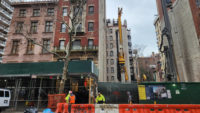Wildfires burning in Canada have dramatically impacted air quality across parts of the eastern U.S. this week, prompting officials to warn against outdoor activity and raising concerns about workers in construction and other labor-intensive fields.
The New York City area experienced the worst air quality in the country June 7, with the state Dept. of Environmental Conservation deeming it “very unhealthy” as the air quality index hit 253—the second-worst rating on an AQI scale which considers a reading of 0-50 “good.” Gary LaBarbera, president of the New York State Building Trades, said in a statement that the labor union group has advised its members about the health risks attributed with the high AQI and requested employers provide N95 masks to those working outdoors.
“Maintaining the health and wellbeing of our members is of utmost importance, and the recent dip in air quality arising from the Canadian wildfires has us very concerned,” he said.
Carlo Scissura, president and CEO of the New York Building Congress, said in a statement that its members were monitoring the situation and individual firms were taking precautions based on guidance from experts and city and state officials.
“We echo the mayor’s urging of all New Yorkers to avoid unnecessary risks, mask up when needed and stay safe,” he said.
By the morning of June 8, the worst pollution had moved south to envelop an area of Pennsylvania including Harrisburg and Philadelphia, with an AQI of more than 350 in some areas, according to AirNow, the U.S. government’s system for tracking AQI. The Pennsylvania Dept. of Environmental Protection was advising everyone in those areas to stay indoors and reduce activity levels. Parts of New Jersey, Delaware, Maryland and Virginia, including the Washington, D.C. metro area, were also experiencing AQI levels deemed “very unhealthy” or “hazardous.”
 Smoke from Canadian wildfires was impacting air quality in parts of the U.S., especially the Northeast. Map courtesy of AirNow
Smoke from Canadian wildfires was impacting air quality in parts of the U.S., especially the Northeast. Map courtesy of AirNow
It is not clear exactly how long the conditions will continue. Officials in states impacted by the smoke have warned it will be at least another day, but the wildfires are poised to remain an issue through the summer. Canadian officials have projected higher than normal wildfire activity across most of the country this year because of drought and forecasted warm temperatures, conditions that are expected to occur with greater frequency and intensity because of climate change. Wildfires have been burning in both western and eastern Canada.
“We are already seeing one of the worst wildfire seasons on record, and we must prepare for a long summer,” Steven Guilbeault, Canadian minister of environment and climate change, said in a statement.
Recommended Protections
State environmental officials in the affected areas have been advising residents to stay indoors if possible. Strenuous activity should be limited, they add. Wildfire smoke exposure symptoms include irritation and inflammation of the eyes, respiratory issues like cough, difficulty breathing and a sore throat, plus fatigue, headache, irregular heartbeat and chest pain, according to Oregon OSHA.
The U.S. Dept. of Labor’s Occupational Safety and Health Administration has regulations for indoor air quality and guidelines on wildfires, but no specific standard for outdoor air quality impacted by wildfire smoke. However, some western states where wildfires are more common have adopted their own standards related to wildfires and air quality as part of state OSHA plans, which may provide employers elsewhere with ideas for protocols to protect their workers’ health while facing bad air quality.
In California, employers must provide respiratory protection equipment approved by the U.S. National Institute for Occupational Safety and Health whenever the AQI exceeds 150. In Oregon, employers must make NIOSH-approved respirators available for voluntary use when the AQI exceeds 100, and respirator use is mandatory when the AQI passes 250. Washington state’s Dept. of Labor & Industries also filed proposed wildfire smoke rules with similar requirements last month, which would require respirators be available for voluntary use at an AQI of more than 100 and mandatory use of respirators when the AQI hits 500.
When picking a mask for protection against wildfire smoke, the U.S. Environmental Protection Agency recommends NIOSH-approved N95 or P100 respirators. The best ones have two straps stretching around the back of the wearer’s head, rather than around the ears, to ensure the tightest seal.
In addition to suggesting masks, LaBarbera said anyone working in a vehicle should keep the windows closed and turn on the air conditioning.
“While it remains unclear how long this will last, we will continue to closely monitor the situation and provide any updated counsel from public health officials on health and safety measures to employers and members,” LaBarbera said.





